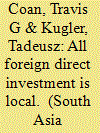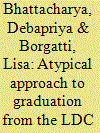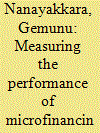|
|
|
Sort Order |
|
|
|
Items / Page
|
|
|
|
|
|
|
| Srl | Item |
| 1 |
ID:
117802


|
|
|
|
|
| Publication |
2012.
|
| Summary/Abstract |
This study focuses on the differences between Indian states in terms of banking infrastructure, size of the economic market and most importantly provincial-level political capacity that creates the pull of foreign direct investment (FDI). While the majority of the extant empirical literature examines national-level data, few studies analyze international capital formation at the provincial level and the dynamics of sub-national political capacity-that is, where allocations are made and policies are implemented. This study corrects for this deficiency. Using data at the provincial level in India over the period 2000-2005, we find an inverted-U-shaped relationship between provincial capacity and FDI, suggesting the presence of a critical point at which additional extractive capabilities have negative implications for foreign capital accumulation. The results suggest a number of important policy implications, allowing researchers to identify specific regions in which capacity is likely to facilitate investment, while also providing a political-economic model to better-forecast changes in investment at the sub-national level in India.
|
|
|
|
|
|
|
|
|
|
|
|
|
|
|
|
| 2 |
ID:
117801


|
|
|
|
|
| Publication |
2012.
|
| Summary/Abstract |
From the creation of the category in 1971, the number of least developed countries (LDCs) has almost doubled to account for 48 members by 2011. Only three countries have managed to exit from the category thus far, and two more are in the pipeline. The recognition of the difficulty of leaving the category is entrenched in the overarching goal of the Fourth UN Conference on LDCs, which specifically calls for halving the number of LDCs within the next decade. The existing asymmetries between the entrance and the graduation criteria have favoured inclusion. Of the three exit criteria, those countries that have graduated, or are in the process of doing so, have all met the low-income exit threshold. This study argues for a graduation path that is not linked to income performance, rather on human capital development. In so doing, it identifies a different, non-conventional route to graduation. Bangladesh makes a good example for it as it is through the development of its human capital assets that it could (a) stop being an LDC and (b) accelerate its rate of economic and income growth. If the appropriate human capital enforcement policies are implemented in the coming 22 years, Bangladesh could meet the graduation thresholds by 2027, graduate out of the LDC group in 2033 and keep all the benefits linked to the LDC status until 2036. At the domestic level, actions aimed at leaving the LDC category have to be framed by, and within, a national employment-generating strategy. The article concludes with specific policy recommendations, particularly related to human capital development, for nearing the estimated graduation date.
|
|
|
|
|
|
|
|
|
|
|
|
|
|
|
|
| 3 |
ID:
117804


|
|
|
|
|
| Publication |
2012.
|
| Summary/Abstract |
This article explores the consequences of financial liberalization policy on the banking sector in Bangladesh. Following a motivating portfolio selection theor-etical model on the impact of liberalization, it applies time series techniques with annual banking sector data for the period 1981-2008. The study suggests that the main objective of financial liberalization to promote domestic private savings by raising real interest rates has not worked. No significant positive correlation is observed between domestic private savings and the real deposit interest rate.
|
|
|
|
|
|
|
|
|
|
|
|
|
|
|
|
| 4 |
ID:
117805


|
|
|
|
|
| Publication |
2012.
|
| Summary/Abstract |
Microfinancing Institutions (MFIs) have grown in popularity as an effective tool for reducing poverty in the developing countries over the last three decades. MFIs are different from traditional financial institutions like banks in many ways. They mainly provide financial assistance (usually without any security) to the needy poor who are denied access to institutional credit from other sources. Data relating to 2007 has shown that there are more than 3,000 MFIs operating around the world. Hundreds of millions of dollars of donor funds are injected into the microfinancing sector. Therefore, the 'performance' of MFIs which affect the effective and efficient utilization of these funds is an important issue. Standard criteria used to measure the performance of commercial enterprises such as profitability, return on investment, share price, etc., are not appropriate to assess the performance of MFIs which have fundamentally different objectives that conflict with commercial interests. This article analyzes the issues relating to criteria used for identifying the performance of MFIs and recommends a new approach to measure the performance of MFIs in an objective manner.
|
|
|
|
|
|
|
|
|
|
|
|
|
|
|
|
| 5 |
ID:
117803


|
|
|
|
|
| Publication |
2012.
|
| Summary/Abstract |
The twin-deficits theory has intrigued economists and policy-makers alike for the past few decades. In a Keynesian economy, budget deficit increases the absorption of the economy, causes import expansions, and thereby, worsens the trade deficit. It also causes domestic interest rates to rise, domestic currency to appreciate, and thereby, contributes to trade deficits. However, according to the Ricardian Equivalence Hypothesis (REH), rising budget deficits imply higher future tax liabilities so people would save more and consume less. As a result, an inter-temporal shift between taxes and budget deficits would have no impact on the real interest, or the trade deficit. Thus, the issue of whether the twin-deficits phenomenon holds becomes more of an empirical question, and the recent fiscal expansions to curb recession makes it timely to revisit the phenomenon, especially for the developing countries confronting both the deficits on a chronic basis. To this end, we make a case study of India, using the bounds- testing approach to cointegration and error-correction modelling on monthly and quarterly data over 1998-2009. Our results suggest that the twin-deficits theory holds for India in the short-run (validating the Keynesian channel) but not in the long-run (validating the REH).
|
|
|
|
|
|
|
|
|
|
|
|
|
|
|
|
| 6 |
ID:
117806


|
|
|
|
|
| Publication |
2012.
|
| Summary/Abstract |
Textiles and Clothing (T&C) is a critically important sector of international trade for developing countries and least developed countries (LDCs). The T&C sector engages abundant labour resources and requires low investment threshold. The T&C sector has been a contentious area in multilateral trade negotiations. With the expiration of quotas in 2005, many T&C dependent countries are experiencing considerable adjustment challenges. Pakistan is one such country that is extensively reliant on T&C industries. This research note presents a brief case study which looks at post-quota developments in Pakistan's T&C trade and the trade and economic policy issues it raises.
|
|
|
|
|
|
|
|
|
|
|
|
|
|
|
|
|
|
|
|
|